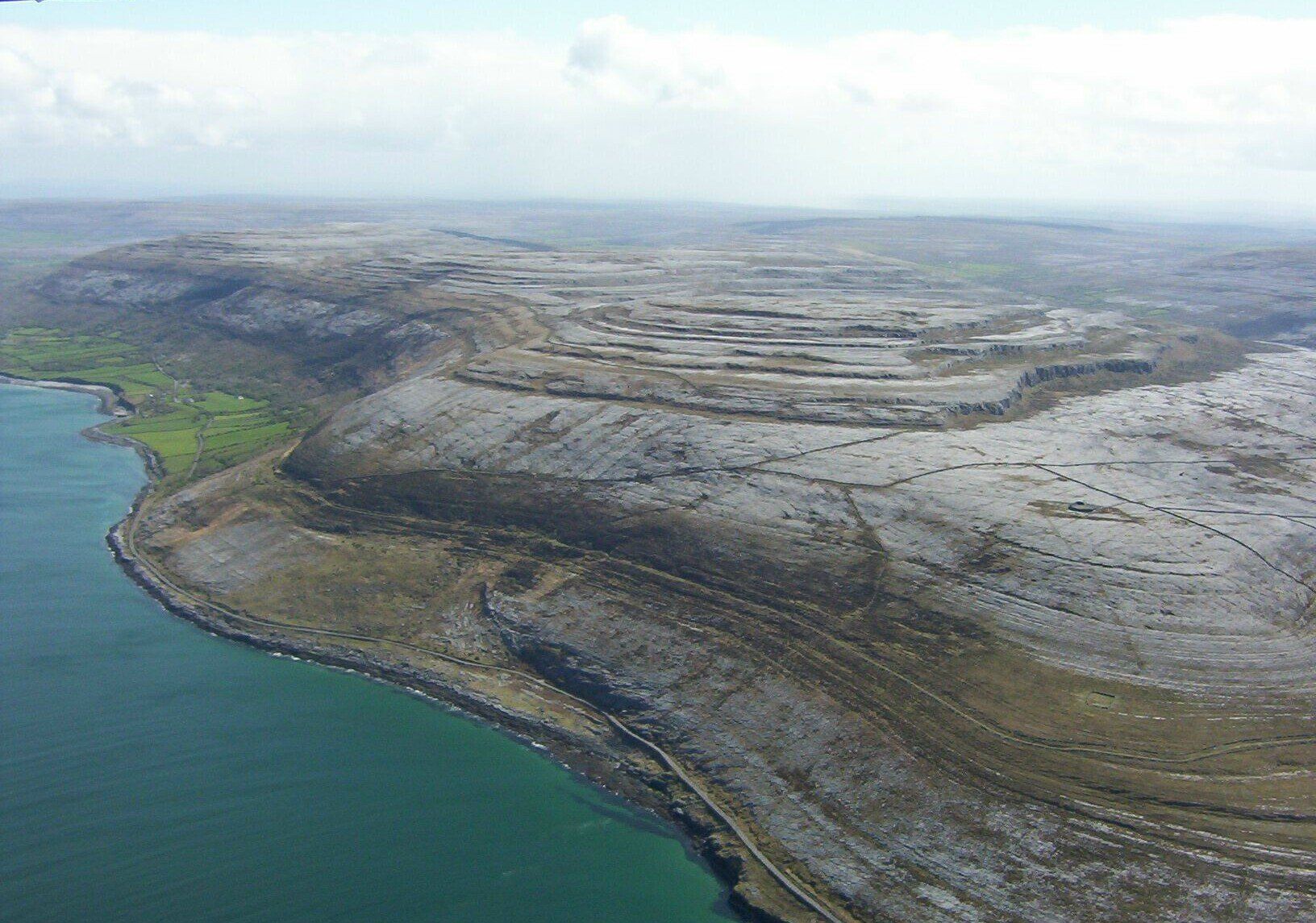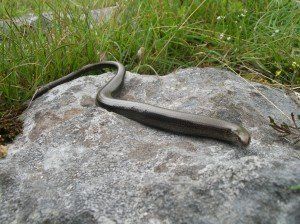Interesting Burren Facts

The Burren is 350 square kilometres (135 sq miles) in size – about 0.5% of the surface of the island of Ireland. The island of Ireland covers 84,431 square kilometres (32,599 sq miles).
The region is enclosed roughly within the circle made by the villages of Ballyvaughan, Kinvara, Gort, Tubber, Corofin, Kilfenora and Lisdoonvarna.
The Aran Islands were formerly part of the Burren. They were detached from the region when sea levels rose at the end of the last Ice Age (circa 10,000 years ago).
The place name the Burren is a phonetic Anglicisation of the Irish place name An Bhoireann which means a place of stone.
The term karst is defined as a landscape formed from the chemical dissolution by rainwater of soluble rocks including limestone, dolomite and gypsum. Karst is a rare and precious land form.The Burren is home to one of the biggest karst landscapes in Europe.
Glaciers and prehistoric agri-vandalism are the twin causes of the extensive soil erosion in the Burren.
The great English map maker and essayist, Connemara-based Tim Robinson (born 1935), said “The Burren’s austere beauty is due to millennia of abuse”
Oliver Cromwell’s lieutenant-general of horse and second-in-command in Ireland Edmund Ludlow (died 1692) said of the Burren “"It is a country where there is not enough water to drown a man, wood enough to hang one, nor earth enough to bury him."
The Burren National Park is one of
six National Parks in the Republic of Ireland and is the smallest one in size –
1,500 hectares approx.
The other five National
Parks are Killarney (Kerry), Wicklow Mountains, Glenveagh (Donegal), Ballycroy (Mayo) and Connemara.
The Burren region is home to five European Union priority habitats for wild flowers – limestone pavement, species-rich grasslands, turloughs, cladium fens and petrifying springs.
There
are only two UNESCO World Heritage sites in the Republic of Ireland – Skellig
Michael (County Kerry) and Brú na Bóinne (County Meath).
The Burren is one of seven sites on an Irish Government Tentative List (2010)
of UNESCO World Heritage Sites. The other sites are Céide Fields and NW Mayo Boglands ; The Monastic
City of Clonmacnoise and its Cultural Landscape ; Dublin - The Historic City of
Dublin ; Early Medieval Monastic Sites (Clonmacnoise, Durrow, Glendalough, Inis
Cealtra, Kells and Monasterboice) ; The Royal Sites of Ireland (Cashel, Dún
Ailinne, Hill of Uisneach, Rathcroghan Complex and Tara Complex) and the
Western Stone Forts.
There are an estimated 1,000 feral goats in the Burren hills – 20% of Ireland’s total population (5,000). The Burren feral goat population is one of the largest in Europe.
Octhebius Nillsoni is a black water beetle with white spots. It was first discovered in a Swedish lake in 1996. It was subsequently found in 2006 in three water bodies in the Burren National Park. Octhebius Nillsoni is one of the rarest creatures on planet earth that we know of. It has no name in the English language.
The Burren limestone is 780 metres thick in places.
The slow worm a nguis fragilis , a legless reptile, was introduced (by misguided people!) to the Burren in Ireland from Great Britain in the late 20th century. It has been expanding its range modestly since its introduction.
The viviparous lizard lacerta vivipara the Burren and Ireland’s only other reptile. It is the most northerly reptile on the planet and can even be found within the Arctic Circle.
The Burren is the only region in the cool, temperate world where livestock are transferred to uplands in winter.
There are approximately 25,000 wild orchids on the planet. Ireland is home to 27 of them and the Burren boasts 23 of this national total.
The east of the Burren is the only area in Ireland where the wild flower dropwort filipendula vulgaris grows.
The Caher river in Fanore is the only river in the Burren
region that flows entirely over ground from source to sea.
Two of Ireland’s three amphibians can be found in the Burren. They are the frog rana and the smooth newt Lissotriton vulgaris. (The 3rd amphibian, Natterjack Toad bufo calamita , is confined in Ireland to County Kerry).
The sparrowhawk Accipiter nisus and the kestrel Falco tinnunculus are the Burren’s two most common birds of prey.
The Burren has one of the highest densities of breeding pair cuckoos Cuculus Canora in Ireland.
Mean rainfall per annum in the Burren is maximum 1,400 millimetres (55 inches). Average annual rainfall in Dublin is 732 millimetres (29 inches) and in Connemara it is 2,800 millimetres (110 inches)
Glenquin House in Kilnaboy was used as the parochial house in the cult sit com TV series Father Ted . However, nearly all the interior scenes were recorded at the ITV Studios facilities in central London in front of a live studio audience.
Two renowned Irish authors, John O’Donohue (1956-2008) and Francis Stuart (1902-2000), are buried in Creggagh cemetery in Fanore village.
Tower houses were the castles of the elite in Ireland from 1400 to 1650. There are three cylindrically shaped tower houses in North Clare – Newtown in Ballyvaughan, Faunarooska in Fanore and Doonagore in Doolin.
The fort was the dwelling/defence structure of the elite prior to the castle. The fort at Ballykinvarga, Kilfenora is one of only 4 forts in Ireland with chevaux de frise (anti-cavalry stone defensive works). The other three are promontory forts - Dunnamoe and Treanbeg in County Mayo and Dún Aengus, Inis Mór.
Sheela na gigs are medieval architectural grotesques. There two in the Burren – one at Kilnaboy church (external) and the other in Ballyportry castle, Corofin (internal).
Round towers are 8th to 1th century stone structues. There are three recorded at monastic sites in the Burren – Kilnaboy, Kilmacduagh and Noughaval. The tower at Noughaval no longer survives.
30 of Ireland’s 32 butterfly species have been recorded in the Burren………… 71 of the national total of 72 land snail species.
In 2011 the Burren and the Cliffs of Moher were awarded the designation of UNESCO Geopark. The status is accorded by UNESCO to sites worldwide which are considered to be of universal geological significance. There are two other Global Geoparks on the island of Ireland – Copper Coast (Waterford) and Marble Arch Caves (Cavan and Fermanagh).




